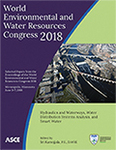World Environmental and Water Resources Congress 2018
Optimal Placement and Operation of Booster Chlorination Stations Using an Advection-Dispersion Transport Model for Chlorine Decay in the Dead-End Pipes
Publication: World Environmental and Water Resources Congress 2018: Hydraulics and Waterways, Water Distribution Systems Analysis, and Smart Water
ABSTRACT
This study investigates the effects of considering an advanced water quality simulation model for finding the optimal layout and operation of a booster chlorination system. Previous studies have generally relied on EPANET, an advection-based water quality model, to simulate the transport and decay of disinfectant residuals. In this study, an advection-dispersion-reaction (ADR) transport model that considers the spatial distribution of flow demands along the dead-end pipe is considered instead. The results suggest that optimization results generated by EPANET may not produce a booster chlorination system that adequately maintains the minimum residual concentration in the periphery pipes of a real-life water distribution system.
Get full access to this chapter
View all available purchase options and get full access to this chapter.
REFERENCES
Abokifa, A. A., Haddad, K., Lo, C. S., and Biswas, P. (2017). “Detection of Cyber Physical Attacks on Water Distribution Systems via Principal Component Analysis and Artificial Neural Networks.” World Environmental and Water Resources Congress 2017, 676–691.
Abokifa, A. A., Yang, Y. J., Lo, C. S., and Biswas, P. (2016a). “Water quality modeling in the dead end sections of drinking water distribution networks.” Water Research, 89, 107–117.
Abokifa, A. A., Yang, Y. J., Lo, C. S., and Biswas, P. (2016b). “Investigating the role of biofilms in trihalomethane formation in water distribution systems with a multicomponent model.” Water Research, 104, 208–219.
Barbeau, B., Gauthier, V., Julienne, K., and Carriere, A. (2005). “Dead-end flushing of a distribution system: Short and long-term effects on water quality.” Journal of Water Supply Research and TechnologyAqua, 54(6), 371–383.
Boccelli, D., Tryby, M. E., Uber, J. G., Rossman, L. a, Zierolf, M. L., and Polycarpou, M. (1998). “Optimal Scheduling of Booster Disinfection in Water Distribution Systems.” Journal of Water Resources Planning and Management, 124(1983), 99–111.
Fisher, I., Kastl, G., and Sathasivan, A. (2011). “Evaluation of suitable chlorine bulk-decay models for water distribution systems.” Water Research, 45(16), 4896–4908.
Galvin, R. (2011). “Eliminate Dead-End Water.” OPFLOW - AWWA Magazine, 37 (11)(November), 20–21.
Hua, P., Vasyukova, E., and Uhl, W. (2015). “A variable reaction rate model for chlorine decay in drinking water due to the reaction with dissolved organic matter.” Water Research, 75(0), 109–122.
Islam, N., Sadiq, R., and Rodriguez, M. J. (2017). “Optimizing Locations for Chlorine Booster Stations in Small Water Distribution Networks.” Journal of Water Resources Planning and Management, 143(7), 4017021.
Li, Z. (2006). “Network Quality Modeling with Stochastic Water Demands and Mass Dispersion.” PhD Dissertation, University of Cincinnati, Cincinnati, Ohio, USA.
Li, Z., Buchberger, S. G., and Tzatchkov, V. (2005). “Importance of Dispersion in Network Water Quality Modeling.” Impacts of Global Climate Change, 1–12.
Maheshwari, A., Abokifa, A. A., Gudi, R. D., and Biswas, P. (2017). “Two-Point Constraint Control of Water Quality in Distribution Networks.” CCWI 2017 – Computing and Control for the Water Industry.
Mala-Jetmarova, H., Sultanova, N., and Savic, D. (2017). “Lost in optimisation of water distribution systems? A literature review of system operation.” Environmental Modelling & Software, 93, 209–254.
Munavalli, G. R., and Kumar, M. S. M. (2003). “Optimal Scheduling of Multiple Chlorine Sources in Water Distribution Systems.” Journal of Water Resources Planning and Management, 129(6), 493–505.
Ohar, Z., Lahav, O., and Ostfeld, A. (2015). “Optimal sensor placement for detecting organophosphate intrusions into water distribution systems.” Water Research, 73, 193–203.
Ohar, Z., and Ostfeld, A. (2014). “Optimal design and operation of booster chlorination stations layout in water distribution systems.” Water Research, 58, 209–220.
Ostfeld, A., and Salomons, E. (2006). “Conjunctive optimal scheduling of pumping and booster chlorine injections in water distribution systems.” Engineering Optimization, Taylor & Francis, 38(3), 337–352.
Ostfeld, A., Salomons, E., Ormsbee, L., Uber, J. G., Bros, C. M., Kalungi, P., Burd, R., Zazula-Coetzee, B., Belrain, T., Kang, D., Lansey, K., Shen, H., McBean, E., Wu, Z. Y., Walski, T., Alvisi, S., Franchini, M., Johnson, J. P., Ghimire, S. R., Barkdoll, B. D., Koppel, T., Vassiljev, A., Kim, J. H., Chung, G., Yoo, D. G., Diao, K., Zhou, Y., Li, J., Liu, Z., Chang, K., Gao, J., Qu, S., Yuan, Y., Prasad, T. D., Laucelli, D., Lyroudia Vamvakeridou, L. S., Kapelan, Z., Savic, D., Berardi, L., Barbaro, G., Giustolisi, O., Asadzadeh, M., Tolson, B. A., and McKillop, R. (2012). “Battle of the water calibration networks.” Journal of Water Resources Planning and Management, 138(5), 523–532.
Rossman, L. A., Clark, R. M., and Grayman, W. M. (1994). “Modeling Chlorine Residuals In Drinking Water Distribution Systems.” Journal of environmental engineering, 120(4), 803–820.
Taylor, G. (1953). “Dispersion of Soluble Matter in Solvent Flowing Slowly through a Tube.” Proceedings of the Royal Society A: Mathematical, Physical and Engineering Sciences, 219(1137), 186–203.
Tryby, M. E., Boccelli, D. L., Koechling, M. T., Uber, J. G., Summers, R. S., and Rossman, L.a (1999). “Booster chlorination.” Journal - American Water Works Association, 91(January), 95–108.
Tzatchkov, V. G., Aldama, A. A., and Arreguin, F. I. (2002). “in Water Distribution Networks.” Journal of Water Resources Planning and Management, 128, 334–342.
U.S. Environmental Protection Agency. (2007). “The Effectiveness of Disinfectant Residuals in the Distribution System.”
Information & Authors
Information
Published In
World Environmental and Water Resources Congress 2018: Hydraulics and Waterways, Water Distribution Systems Analysis, and Smart Water
Pages: 380 - 389
Editor: Sri Kamojjala, Las Vegas Valley Water District
ISBN (Online): 978-0-7844-8142-4
Copyright
© 2018 American Society of Civil Engineers.
History
Published online: May 31, 2018
Authors
Metrics & Citations
Metrics
Citations
Download citation
If you have the appropriate software installed, you can download article citation data to the citation manager of your choice. Simply select your manager software from the list below and click Download.
